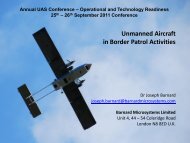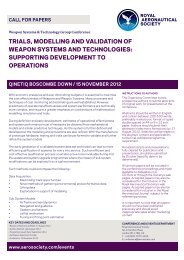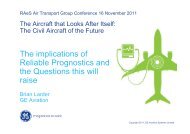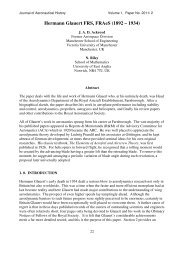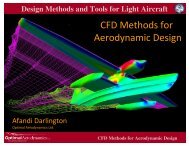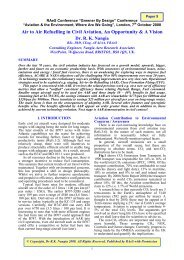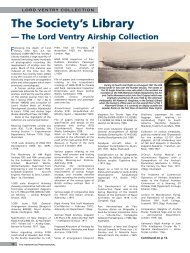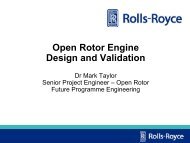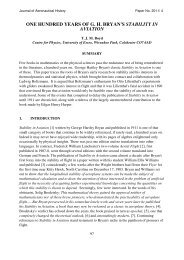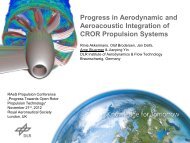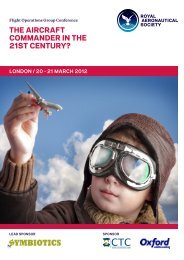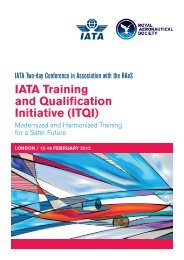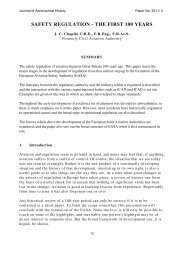Smoke, Fire and Fumes in Transport Aircraft - Royal Aeronautical ...
Smoke, Fire and Fumes in Transport Aircraft - Royal Aeronautical ...
Smoke, Fire and Fumes in Transport Aircraft - Royal Aeronautical ...
Create successful ePaper yourself
Turn your PDF publications into a flip-book with our unique Google optimized e-Paper software.
If it is cont<strong>in</strong>u<strong>in</strong>g, crews are commonly <strong>in</strong>structed to reverse the<br />
action(s) just taken (i.e., turn the switch(es) back on) <strong>and</strong> proceed<br />
with mak<strong>in</strong>g the next configuration change. One drawback to this<br />
approach is that it can be quite time consum<strong>in</strong>g to complete these<br />
steps particularly because it can take several m<strong>in</strong>utes for crews to tell<br />
if the configuration change they just completed has had the desired<br />
effect. Nonetheless, given the state of current technology <strong>and</strong> aircraft<br />
design, complet<strong>in</strong>g such stepwise actions is typically the only way<br />
that crews can identify <strong>and</strong> isolate a hidden source of SFF.<br />
The steer<strong>in</strong>g committee’s checklist template <strong>and</strong> <strong>in</strong>tegrated air carrier<br />
SFF checklists do <strong>in</strong>clude sections of system-specific source<br />
identification items (<strong>in</strong> the template, these are Sections 12, 13, <strong>and</strong><br />
14). However, <strong>in</strong> both the template <strong>and</strong> <strong>in</strong> United Airl<strong>in</strong>e’s <strong>in</strong>tegrated<br />
checklist, these system-specific steps follow earlier steps designed to<br />
isolate <strong>and</strong> elim<strong>in</strong>ate a source of SFF that do not <strong>in</strong>volve a systematic,<br />
system-specific analysis of actions. As mentioned above, these<br />
earlier steps remove “the most likely sources” of SFF as determ<strong>in</strong>ed<br />
by the history of the aircraft type.<br />
For example, follow<strong>in</strong>g the completion of crew self-protection <strong>and</strong><br />
communication steps <strong>in</strong> the template (Steps 1-4), crews would<br />
complete items related to Step 5, which states “Manufacturer’s <strong>in</strong>itial<br />
steps…….Accomplish.” In the accompany<strong>in</strong>g philosophy document,<br />
“manufacturer’s <strong>in</strong>itial steps” are described as those “that remove the<br />
most probable smoke/fumes sources <strong>and</strong> reduce risk…These steps<br />
should be determ<strong>in</strong>ed by model-specific historical data or analysis.”<br />
Furthermore, the philosophy specifies that these <strong>in</strong>itial steps “should<br />
be quick, simple <strong>and</strong> reversible; will not make the situation worse or<br />
<strong>in</strong>hibit further assessment of the situation; <strong>and</strong>, do not require<br />
analysis by the crew.”<br />
Thus, when us<strong>in</strong>g a checklist designed accord<strong>in</strong>g to the template,<br />
crews will elim<strong>in</strong>ate the most likely sources of SFF early on dur<strong>in</strong>g<br />
checklist completion without mak<strong>in</strong>g a determ<strong>in</strong>ation first as to<br />
whether one of these sources is <strong>in</strong> fact caus<strong>in</strong>g the smoke, fire, or<br />
fumes; this step <strong>in</strong>volves source isolation/elim<strong>in</strong>ation but not source<br />
identification. Hence, a crew may complete the checklist successfully<br />
(i.e., fire is ext<strong>in</strong>guished, smoke is dissipat<strong>in</strong>g) without ever hav<strong>in</strong>g<br />
positively identified the source of the SFF.<br />
Design Tradeoffs: Lengthy Source Identification vs Quick Source<br />
Elim<strong>in</strong>ation. The <strong>in</strong>clusion of both system-specific source<br />
identification items as well as smoke elim<strong>in</strong>ation items that do not<br />
require source identification <strong>in</strong> <strong>in</strong>tegrated SFF checklists addresses<br />
two, sometimes compet<strong>in</strong>g needs felt by the crews when deal<strong>in</strong>g with<br />
these events. When they are needed <strong>and</strong> time is available, items that<br />
support a systematic identification of a SFF source are available.<br />
Likewise, actions that will elim<strong>in</strong>ate the most likely sources of SFF are<br />
also provided allow<strong>in</strong>g the possibility of quickly elim<strong>in</strong>at<strong>in</strong>g a source<br />
without requir<strong>in</strong>g lengthy <strong>and</strong> systematic analysis.<br />
Conclusion<br />
The construction <strong>and</strong> design of checklists to be used for non-alerted<br />
SFF events is very challeng<strong>in</strong>g. The types of events for which they<br />
might be needed vary widely but, at their extreme, are highly timecritical<br />
<strong>and</strong> life threaten<strong>in</strong>g. Additionally, the cues available to crews<br />
may not be very helpful <strong>in</strong> determ<strong>in</strong><strong>in</strong>g their situation <strong>and</strong> at times may<br />
actually be mislead<strong>in</strong>g. The <strong>in</strong>dustry is mov<strong>in</strong>g toward the use of<br />
<strong>in</strong>tegrated checklists to guide crew response to non-alerted SFF<br />
events. In this way, it is hoped that crews may be better supported <strong>in</strong><br />
their h<strong>and</strong>l<strong>in</strong>g of these very challeng<strong>in</strong>g events.<br />
Acknowledgements<br />
The author would like to thank Key Dismukes, Ben Berman, <strong>and</strong> Mike<br />
Feary for their helpful comments on an earlier draft of this paper. An<br />
earlier version of this paper appeared <strong>in</strong> the Proceed<strong>in</strong>gs of the 2005<br />
International Society of Air Safety Investigators (ISASI) Annual<br />
Meet<strong>in</strong>g. The author is also very grateful to Capta<strong>in</strong> Rich Gilbert,<br />
Capta<strong>in</strong> Emil Lassen, <strong>and</strong> Capta<strong>in</strong> Jerry Gossner for their able<br />
assistance, <strong>in</strong>sight, <strong>and</strong> guidance, <strong>and</strong> to United Airl<strong>in</strong>es for<br />
permission to use their checklist <strong>in</strong> this Appendix.<br />
Endnotes<br />
1Beg<strong>in</strong>n<strong>in</strong>g <strong>in</strong> 2004, a ‘steer<strong>in</strong>g committee’ of approximately ten<br />
<strong>in</strong>dividuals began meet<strong>in</strong>g to develop non-alerted SFF checklist<br />
design guidance that could be adopted across the <strong>in</strong>dustry.<br />
Representatives from four major aircraft manufacturers (Airbus,<br />
Boe<strong>in</strong>g, Bombardier, <strong>and</strong> Embraer), the International Federation of Air<br />
L<strong>in</strong>e Pilots Associations (IFALPA), <strong>and</strong> four air carriers (Air Canada,<br />
British Airways, Delta, <strong>and</strong> United) comprised the steer<strong>in</strong>g committee.<br />
Dur<strong>in</strong>g the development process, one meet<strong>in</strong>g was also held, which<br />
the author attended, whereby feedback was solicited from <strong>in</strong>dividuals<br />
represent<strong>in</strong>g other <strong>in</strong>dustry groups (e.g., FAA, NASA, NTSB, TSB of<br />
Canada, etc.).<br />
The steer<strong>in</strong>g committee has recently completed two products it hopes<br />
will be adopted by the <strong>in</strong>ternational aviation <strong>in</strong>dustry as the st<strong>and</strong>ards<br />
that will guide the design <strong>and</strong> content of non-alerted SFF checklists<br />
(Flight Safety Foundation, 2005). One product is a template to be<br />
used by designers when develop<strong>in</strong>g a non-alerted SFF checklist <strong>and</strong><br />
the other is a description of the philosophy upon which the template<br />
is founded, as well as a few def<strong>in</strong>itions of various terms <strong>and</strong> concepts<br />
used <strong>in</strong> the template. Both products are <strong>in</strong>cluded <strong>in</strong> this Appendix. It<br />
is important to note that the template is not, <strong>in</strong> <strong>and</strong> of itself, a checklist.<br />
As its name states, it is a framework to guide checklist design <strong>and</strong><br />
content. Some of the steps on the template are actually sections <strong>and</strong><br />
several checklist items might be developed for a s<strong>in</strong>gle template<br />
“step.” The accompany<strong>in</strong>g philosophy <strong>and</strong> concept def<strong>in</strong>itions must<br />
also be consulted dur<strong>in</strong>g checklist development so that the result<strong>in</strong>g<br />
checklist is truly <strong>in</strong> keep<strong>in</strong>g with the <strong>in</strong>tent of the template.<br />
References<br />
BLAKE, D. (2000). <strong>Aircraft</strong> cargo compartment smoke detector alarm<br />
<strong>in</strong>cidents on US-registered aircraft, 1974-1999. Technical Note,<br />
DOT/FAA/AR-TN00/29. Atlantic City, NJ: FAA.<br />
Federal Aviation Adm<strong>in</strong>istration (1996). Human factors design guide.<br />
Atlantic City, NJ: FAA.<br />
Flight Safety Foundation (June 2005). Flight crew procedures<br />
streaml<strong>in</strong>ed for smoke/fire/fumes. Flight Safety Digest.<br />
National <strong>Transport</strong>ation Safety Board (1974). <strong>Aircraft</strong> Accident Report<br />
— Pan American World Airways, Inc, Boe<strong>in</strong>g 707-321C, N458PA,<br />
Boston, Massachusetts, 3 November 1973. Report Number NTSB<br />
AAR-74-16. Wash<strong>in</strong>gton, DC: NTSB.<br />
National <strong>Transport</strong>ation Safety Board (1998). <strong>Aircraft</strong> Accident Report<br />
— In-flight <strong>Fire</strong>/Emergency L<strong>and</strong><strong>in</strong>g, Federal Express Flight 1406,<br />
Douglas DC-10-10, N68055, Newburgh, New York, 5 September<br />
1996. Report Number NTSB AAR-98/03. Wash<strong>in</strong>gton, DC: NTSB.<br />
<strong>Transport</strong>ation Safety Board of Canada (2003). Aviation Investigation<br />
Report A98H0003, In-flight <strong>Fire</strong> Lead<strong>in</strong>g To Collision with Water,<br />
Swissair <strong>Transport</strong> Limited McDonnell Douglas MD-11 HB-IWF,<br />
Peggy’s Cove, Nova Scotia 5nm SW, 2 September 1998. Gat<strong>in</strong>eau,<br />
Quebec, Canada: TSB of Canada.<br />
FEBRUARY 2007 25



